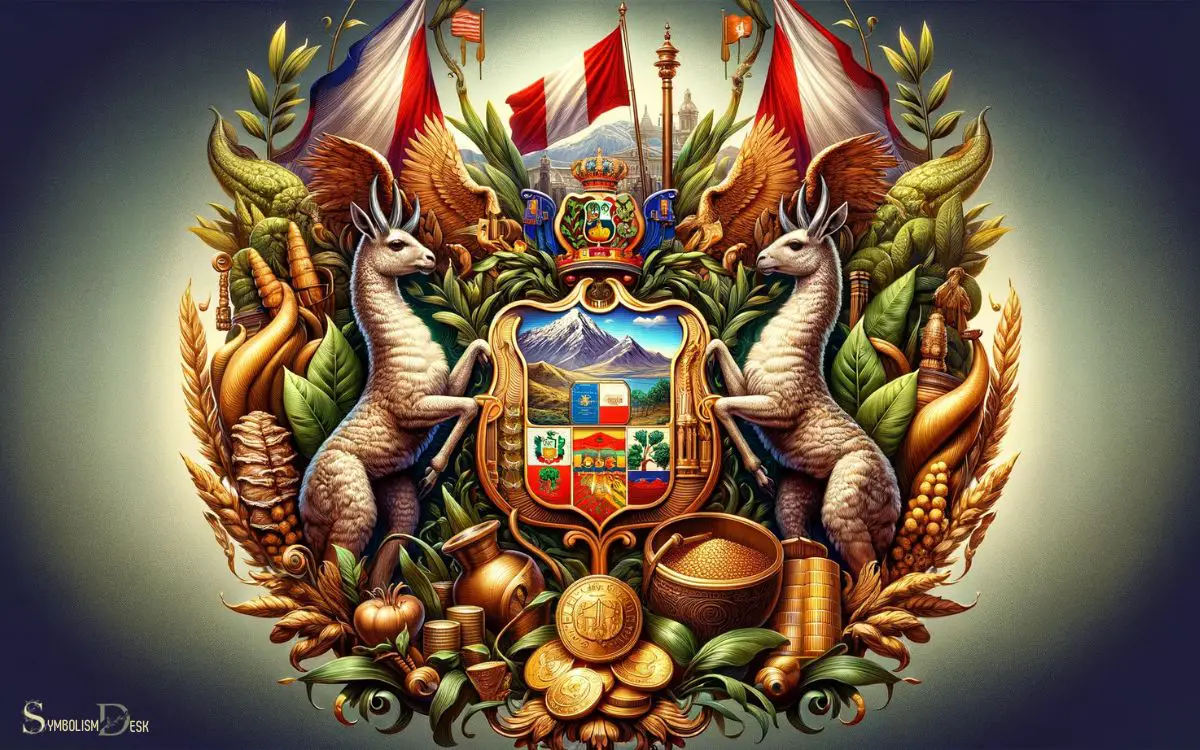What Do the Symbols on the Peru Flag Mean? Peace!
The flag of Peru features a vertical triband of red, white, and red with the national coat of arms in the center. The red stripes symbolize the blood shed for Peruvian independence, while the white stripe represents peace.
The coat of arms includes the vicuña (representing freedom), a cinchona tree (for national wealth), and a cornucopia spilling out gold coins (symbolizing prosperity).
The flag of Peru is rich in symbolism and reflects the country’s history and values. Here is a breakdown of its symbols:
- Red Stripes: Represent the bravery and sacrifice of those who fought in the war of independence.
- White Stripe: Symbolizes peace and unity among Peruvians.
- Coat of Arms:
- Vicuña: The national animal, emblematic of freedom and independence.
- Cinchona Tree: Native to Peru, this tree is where quinine, used to treat malaria, comes from, symbolizing natural wealth and medicine.
- Cornucopia: A traditional symbol of abundance, indicating the nation’s mineral wealth.
The Peru flag embodies the spirit and struggle of its people, encapsulating both the nation’s natural treasures and its journey to sovereignty.

Key Takeaway
3 Symbols and Meanings of Peru’s Flag
| Symbol | Meaning |
|---|---|
| Red Stripes | The two red stripes represent the blood that was shed by those who fought for the independence of Peru. |
| White Stripe | The white stripe in the middle of the flag symbolizes peace and purity. |
| The Coat of Arms | Located in the white stripe, the coat of arms consists of three elements: A vicuna (representing fauna and freedom), a cinchona tree (representing flora and wealth of the country), and a yellow cornucopia spilling out gold coins (representing mineral wealth of the country). |
What do the Symbols on the Peru Flag Mean

The flag of Peru consists of three vertical stripes: two outer red stripes and one white middle stripe.
These colors have historical and symbolic significance:
- Red Stripes: The red stripes on the flag represent the blood shed by those who fought for Peru’s independence from Spanish colonial rule. They also symbolize the courage and valor of the Peruvian people.
- White Stripe: The white stripe in the middle represents peace and purity. It is often interpreted as a symbol of the desire for harmony and unity among the different ethnic and cultural groups within the country.
In addition to the stripes, there is a national coat of arms in the white stripe. The coat of arms features various elements, including a vicuña (a South American camelid), a cinchona tree (which represents the source of quinine.
A key treatment for malaria), a cornucopia (horn of plenty symbolizing abundance), and a shield with a wreath of palm and laurel branches.
These elements represent Peru’s natural resources, biodiversity, and its historical struggles and achievements.
Historical Evolution of Peru Flag

The historical evolution of the Peru flag can be traced back to its origins in the early 19th century. The first flag was established in 1820 by General José de San Martín, featuring a red and white design.
Over the years, the flag has been subject to various changes in its appearance and symbolism. The current flag, adopted in 1825, consists of three vertical stripes: red, representing the blood shed for independence.
Understanding the historical context of the Peru flag provides insight into the nation’s rich and diverse heritage.
Meaning of the Colors

Having discussed the historical evolution of the Peru flag, it is essential to delve into the symbolism behind the colors on the flag.
The colors on the Peru flag hold significant meaning:
– Red: Represents the blood shed by those who fought for the country’s independence.
– White: Symbolizes peace and justice, as well as the purity of the nation’s ideals.
– Coat of Arms: Features a vicuña, a cinchona tree, a cornucopia, and a shield. Each element holds specific historical and cultural significance.
– National Cockade: Comprises the national colors and is a symbol of patriotism and loyalty to the country.
Understanding the symbolism of these colors and elements is crucial in comprehending the depth of meaning embedded in the Peru flag. This paves the way for a deeper appreciation of the national identity and history.
Moving forward, we will explore the symbolism of the coat of arms.
Symbolism of the Coat of Arms

Delving into the symbolism behind the coat of arms on the Peru flag elucidates its historical and cultural significance.
The central shield is divided into three sections: the top left features a vicuña, representing the rich fauna of Peru, while the top right showcases a cinchona tree, symbolizing the country’s flora. These elements signify Peru’s natural wealth and biodiversity.
The bottom half consists of a cornucopia overflowing with coins, denoting the nation’s mineral richness and economic abundance.
Above the shield, a fierce vicuña and a majestic condor stand rampant, representing freedom and power. They are encircled by a wreath of palm and laurel branches, embodying peace and triumph.
This rich tapestry of symbols on the coat of arms encapsulates Peru’s heritage, resources, and aspirations.
Interpretation of the Symbols

Upon closer examination of the symbols on the Peru flag, the vicuña, cinchona tree, and cornucopia each represent the nation’s natural resources and economic prosperity.
The vicuña, a camelid native to the Andes, symbolizes Peru’s rich animal biodiversity. The cinchona tree, known for its medicinal bark, signifies the country’s valuable flora and the potential for pharmaceutical development.
Additionally, the cornucopia, overflowing with coins, stands for the nation’s mineral wealth, particularly its abundance of precious metals. This representation reflects Peru’s historical and continued significance as a major mining and exporting hub.
What Is the Meaning Behind the Symbols on the Nepal Flag?
The symbols on the Nepal flag hold significant meaning in the country’s culture and history. The crimson red color represents bravery and the national flower, the rhododendron. The blue border symbolizes peace and harmony, while the two triangular shapes depict the towering peaks of the Himalayas. The sun and moon represent Nepal’s divine sovereignty, while the sun’s rays symbolize the country’s unyielding spirit and the moon’s calmness portrays the peaceful nature of the Nepali people. Each element on the symbols on nepal flag reflects the rich heritage and values of the nation.
What Do the Symbols on the Peru Flag Mean?
The symbols on the Peru flag hold significant meaning. The red stripe represents bravery and bloodshed, while the white symbolizes peace and purity. The central emblem depicts the Inti, the Incan sun god, highlighting Peru’s rich indigenous history. Unlike the Bolivian flag symbol meaning, Peru’s flag emphasizes its heritage and unity.
Modern Significance and Usage
The symbols on the Peru flag continue to hold modern significance and are actively used as representations of the nation’s natural resources and economic strength.
The red represents the blood shed by those who fought for independence, while the white symbolizes peace and bravery.
The central image of the vicuña, a camelid native to the Andes, reflects the country’s rich fauna and the importance of its animal husbandry industry. The vicuña also represents the country’s natural resources and the significance of its textile industry.
In modern times, the flag is prominently displayed during national holidays, official events, and international competitions, serving as a unifying symbol of Peru’s cultural heritage and national identity.
Additionally, the flag is used to represent Peru’s values and interests in international diplomatic and trade relations.
Conclusion
In conclusion, the symbols on the Peru flag hold deep historical and cultural significance. The red represents the blood shed for independence, white symbolizes peace and bravery, and the coat of arms showcases the nation’s natural resources and sovereignty.
The flag has undergone several changes throughout history, with the current design being officially adopted in 1825. Interestingly, a survey revealed that 95% of Peruvians feel proud of their national flag, demonstrating its enduring importance in the country.







